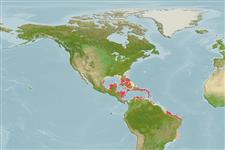Common names from other countries
Environment: milieu / climate zone / depth range / distribution range
Ecologia
marino associati a barriera corallina; distribuzione batimetrica 2 - 24 m (Ref. 9710). Tropical; 36°N - 25°S, 99°W - 32°W
Western Atlantic: North Carolina, USA and Bermuda to Brazil.
Size / Peso / Age
Maturity: Lm ? range ? - ? cm
Max length : 18.0 cm TL maschio/sesso non determinato; (Ref. 7251)
Spine dorsali (totale) : 9; Raggi dorsali molli (totale) : 11; Spine anali: 3; Raggi anali molli: 11. Wide black stripe through eye to base of tail, bordered above by prominent gold line. Large black spot on mid-side. Large black spot on mid-side above origin of anal fin (Ref. 26938). Three transverse red bands on top of head; large adult males become primarily rose and green, lose the dark lateral stripe, gain a prominent black spot on mid-side, and have a larger black spot in the spinous portion of the dorsal fin (Ref. 13442).
Abundant on reef tops and in shallow rocky areas. Found to depths of at least 25 m (Ref. 26938). Also found in Sargassum beds (Ref. 9626). Solitary and wary and can be difficult to approach (Ref. 26938). The tricolored pattern of the initial phase is similar to that of the juveniles of the yellowmouth grouper, Mycteroperca interstitialis, an aggressive mimic (Ref. 43465). A protogynous hermaphrodite (Ref. 55367). Generally of no interest to fisheries because of its small average size (Ref. 5217).
Life cycle and mating behavior
Maturities | Riproduzione | Spawnings | Egg(s) | Fecundities | Larve
Diandric. Forms leks during breeding (Ref. 55367). Length at sex change = 10.9 cm TL (Ref. 55367).
Robins, C.R. and G.C. Ray, 1986. A field guide to Atlantic coast fishes of North America. Houghton Mifflin Company, Boston, U.S.A. 354 p. (Ref. 7251)
IUCN Red List Status (Ref. 130435)
CITES (Ref. 128078)
Not Evaluated
Threat to humans
Harmless
Human uses
Pesca: commerciale; Acquario: Commerciale
Strumenti
Special reports
Download XML
Fonti Internet
Estimates based on models
Preferred temperature (Ref.
115969): 25.5 - 28.2, mean 27.4 (based on 685 cells).
Phylogenetic diversity index (Ref.
82804): PD
50 = 0.5000 [Uniqueness, from 0.5 = low to 2.0 = high].
Bayesian length-weight: a=0.01047 (0.00604 - 0.01816), b=3.21 (3.06 - 3.36), in cm Total Length, based on LWR estimates for this species & Genus-body shape (Ref.
93245).
Trophic level (Ref.
69278): 3.3 ±0.2 se; based on diet studies.
Resilienza (Ref.
120179): Alto, tempo minimo di raddoppiamento della popolazione meno di 15 mesi (Preliminary K or Fecundity.).
Fishing Vulnerability (Ref.
59153): Low vulnerability (10 of 100).
